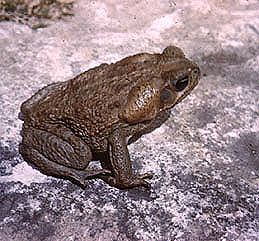
These nocturnal amphibians are natives of many tropical nations including Hawaii, Fiji, and the Philippines. They range also from South America through Texas and are also found in Florida (The Morning Glory Site, 2001). Cane toads have also been thriving in Australia since their introduction in 1935 (Lewis, 1987).
Diet seems to be limited only by whether the toad can fit a prospective food item into its mouth. Dietary staples include insects, other reptiles and amphibians, other members of its own species, and small rodents. Cane toads also commonly devour cat food, carpet, bits of plastic, and other bizarre items.
Cane toads produce a thick, white venom that is excreted both through the skin and through the paratoid glands that run laterally down their bodies. This venom is cardioactive in nature as it causes vasodilatation when ingested or when it comes in contact with mucous membranes. Other observed symptoms are tachycardia, severe vomiting, sinus arrhythmia, and severe lethargy (Spoerke, 1986). It is also believed by many that the venom has psychotropic capabilities when ingested or smoked